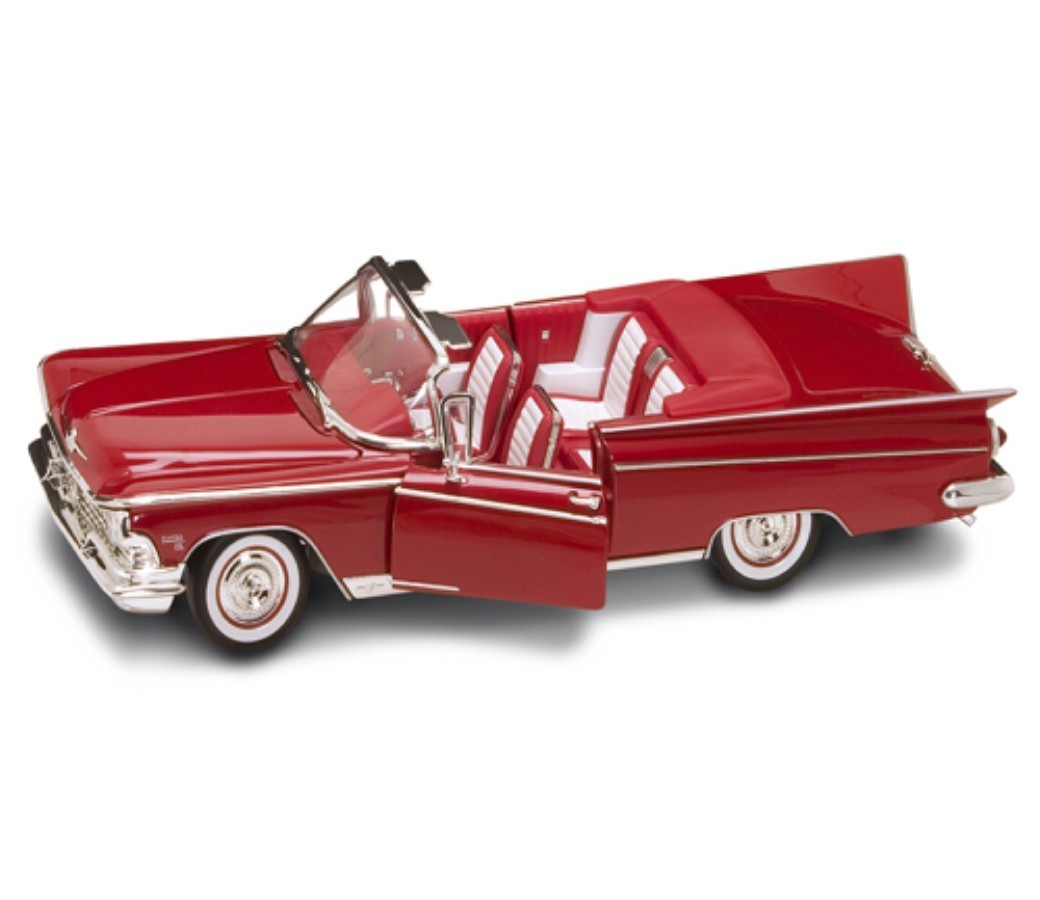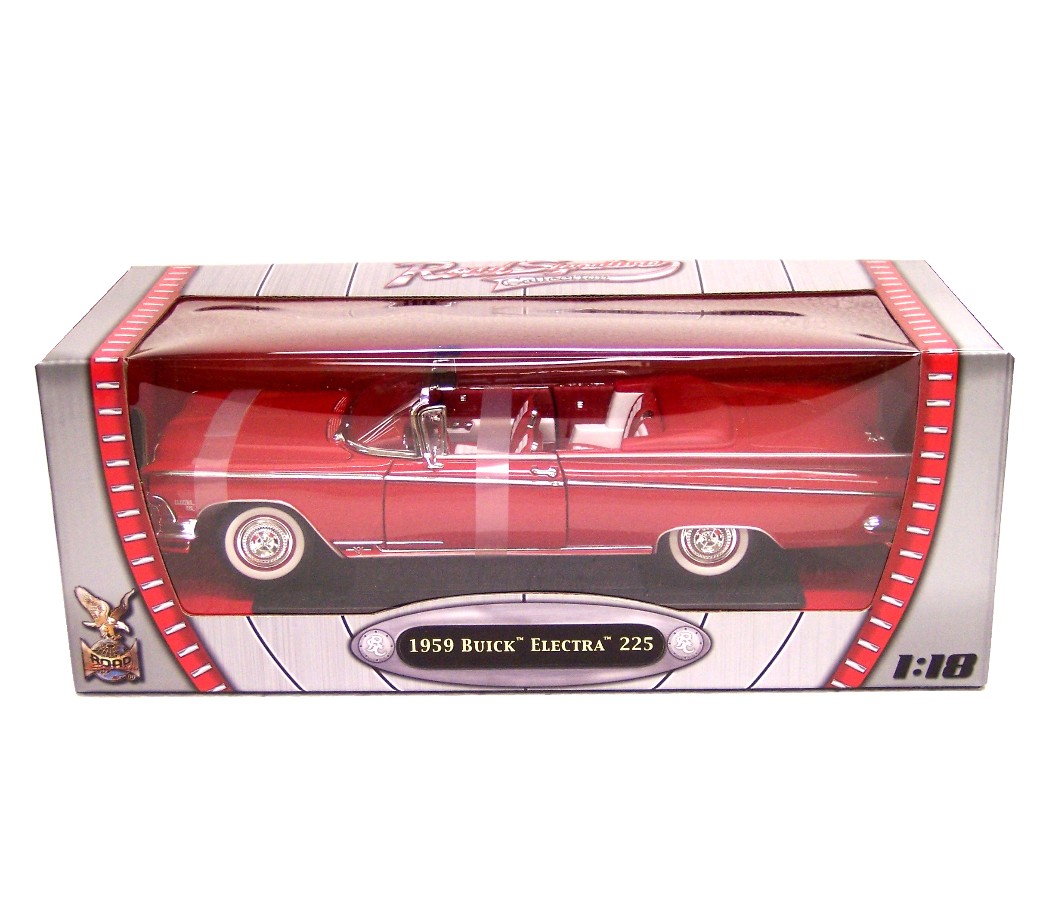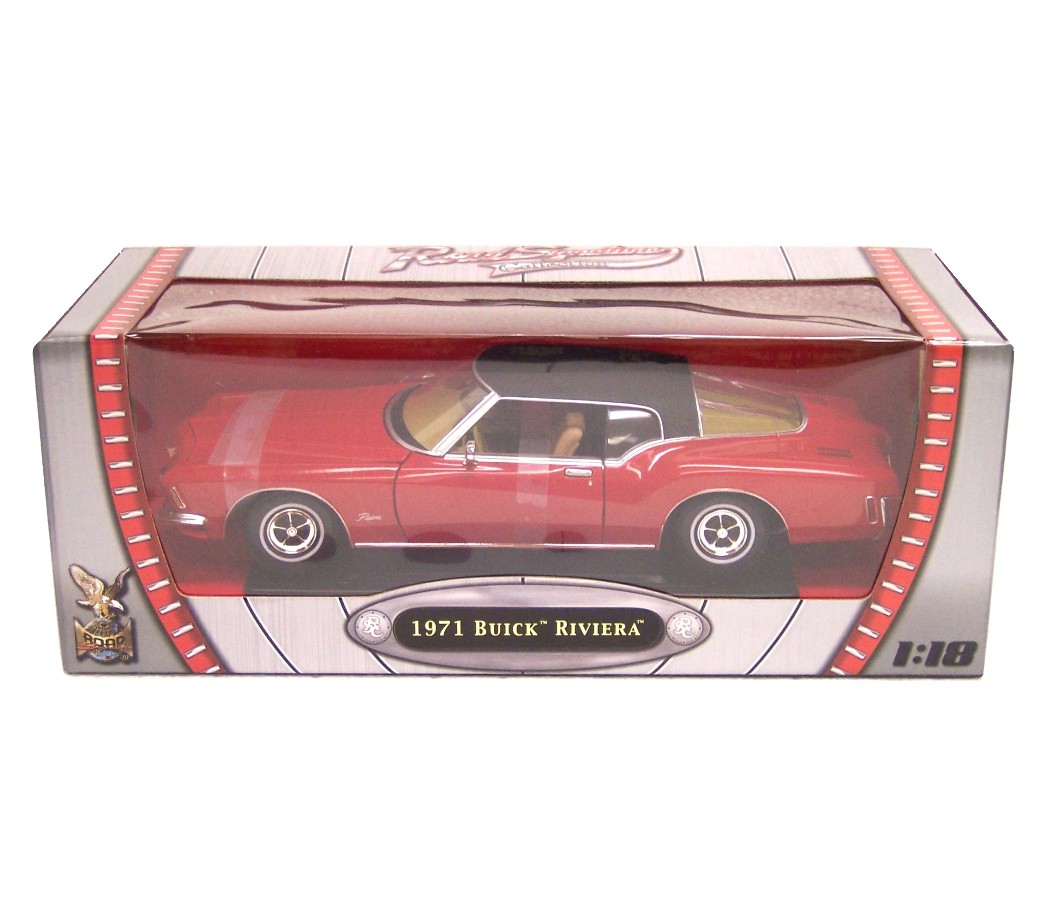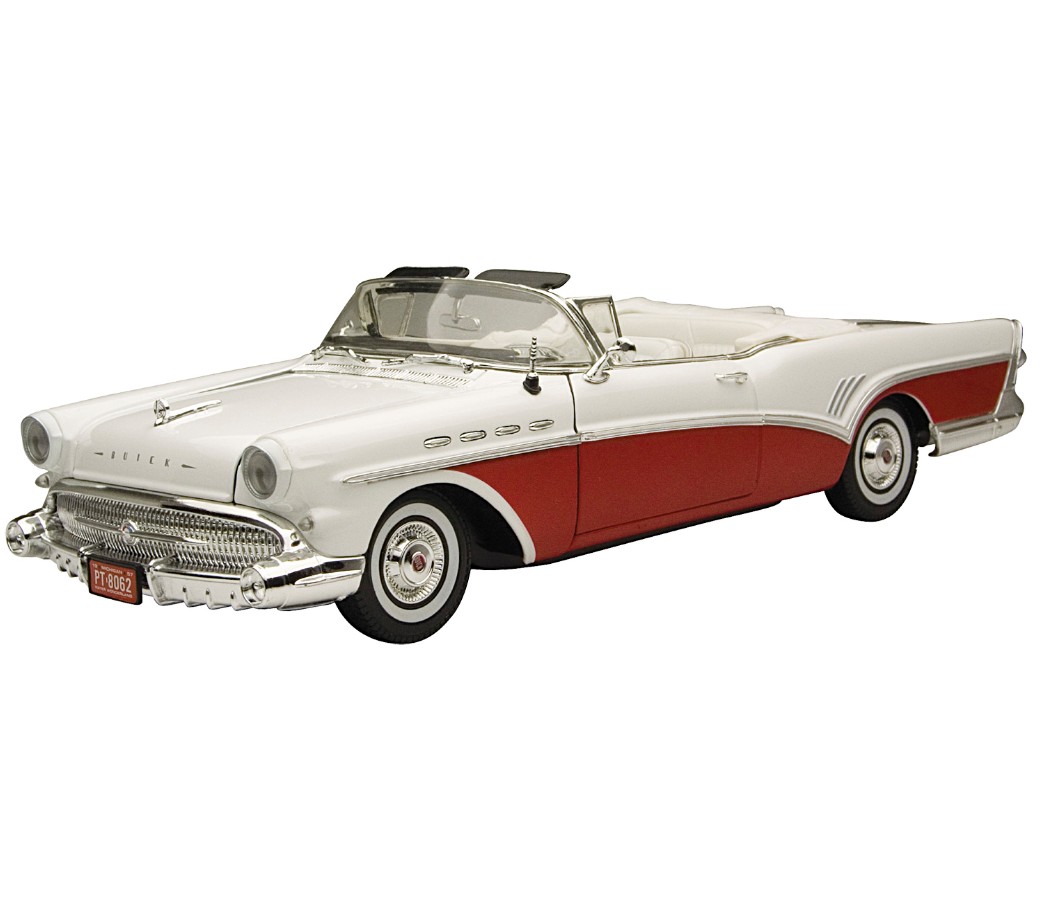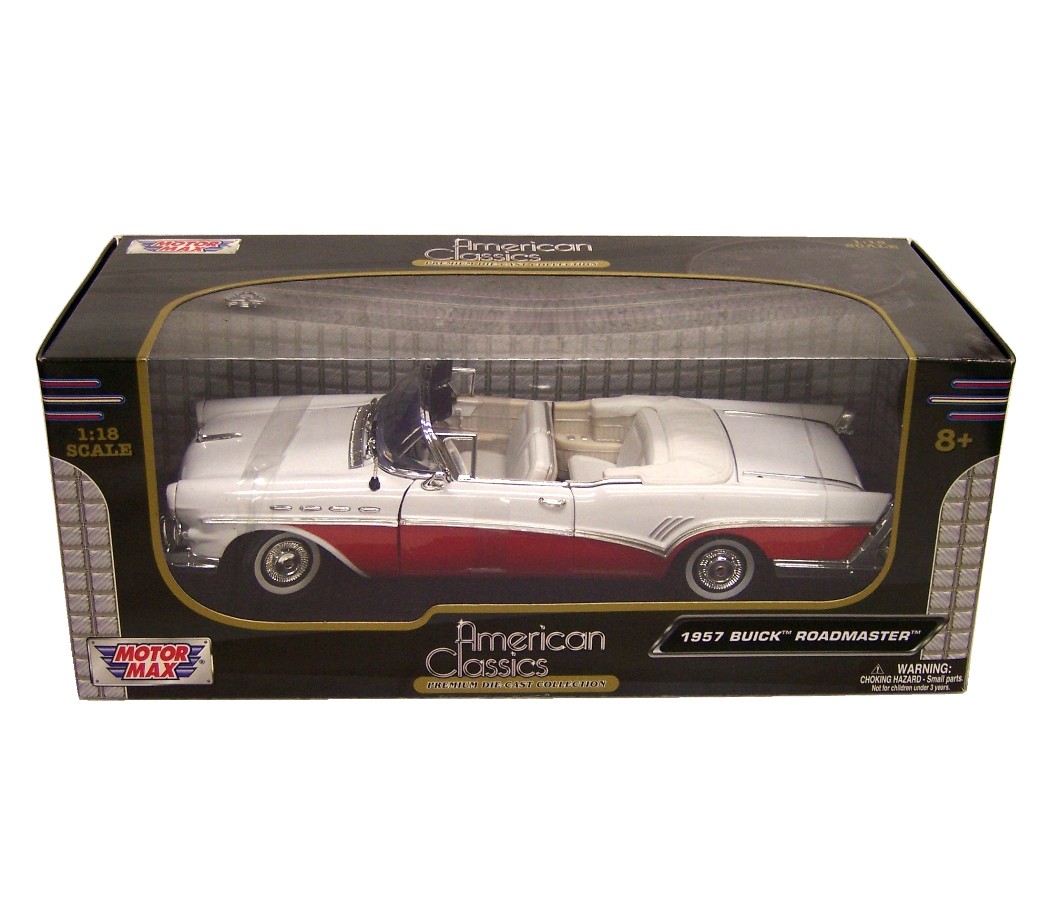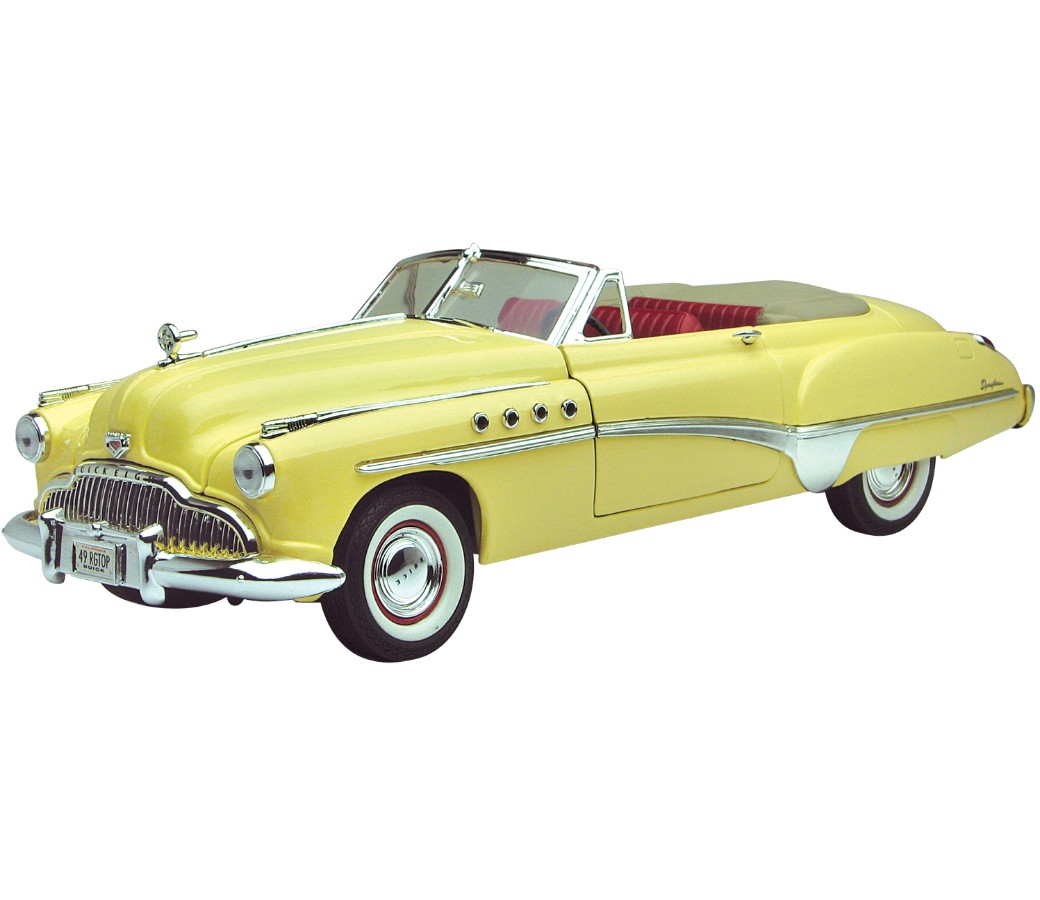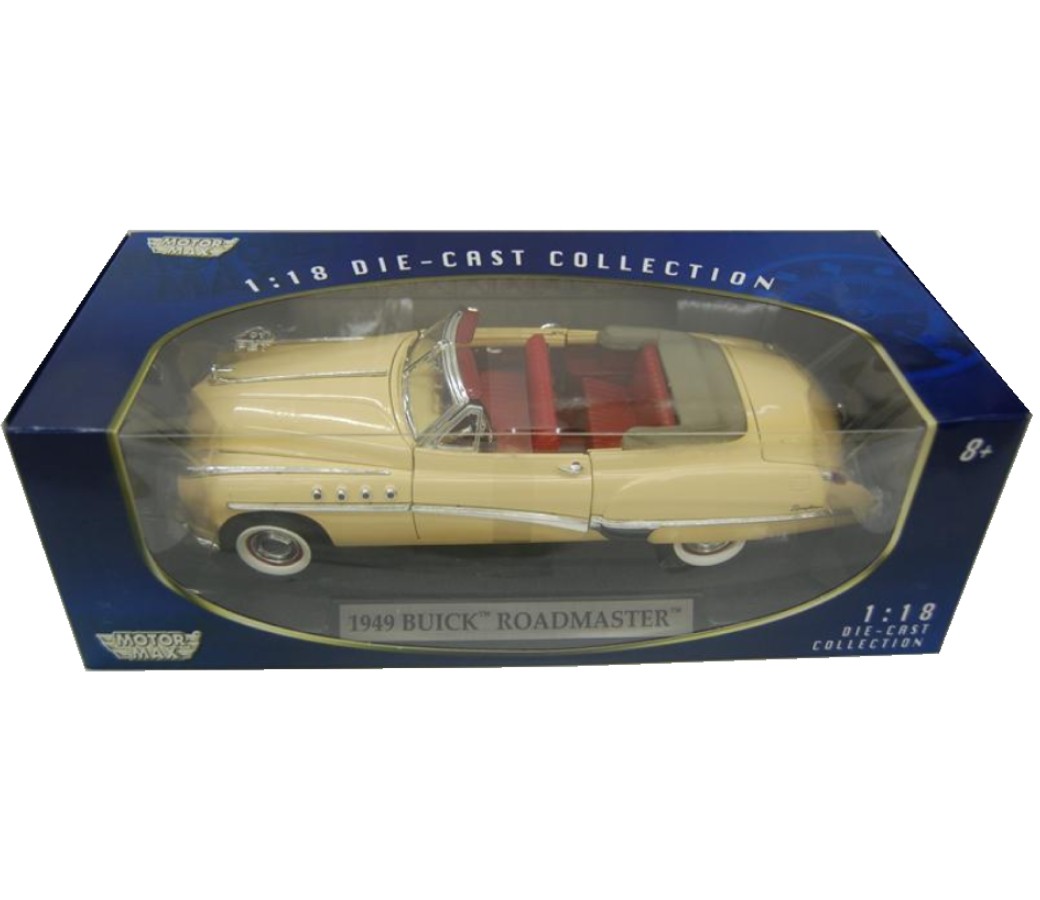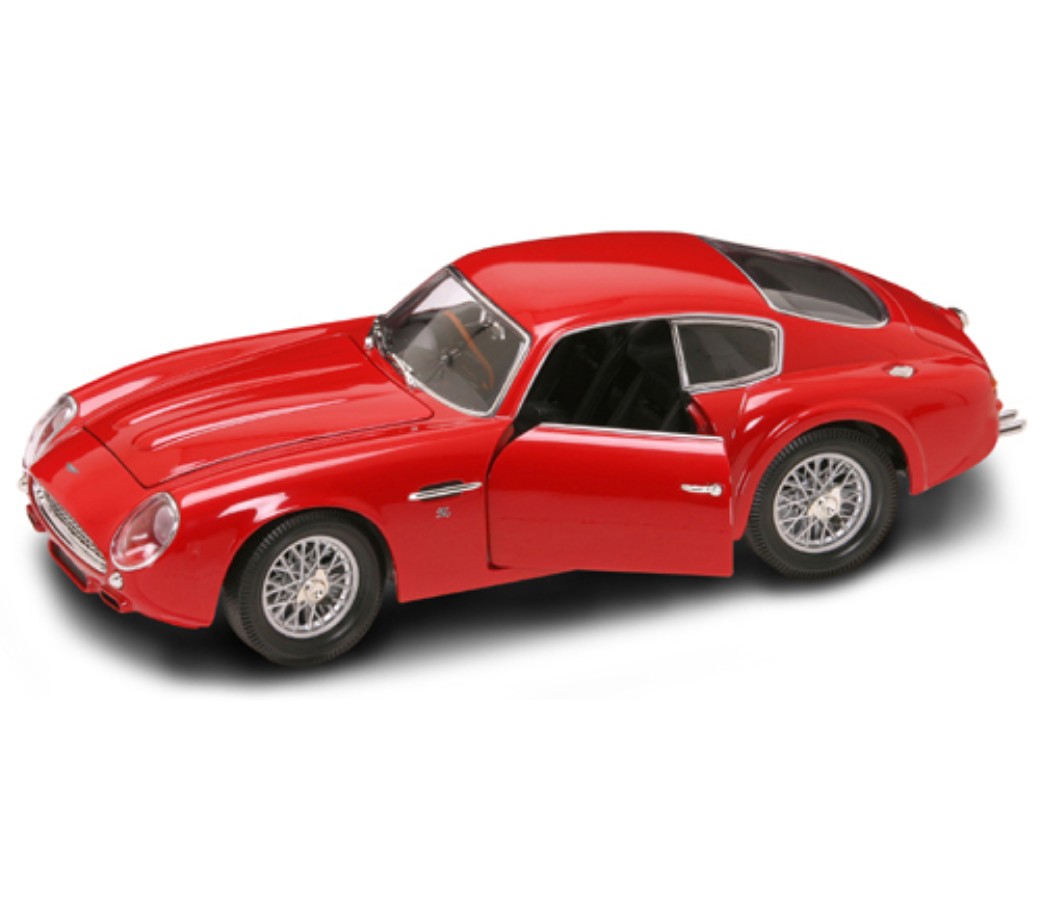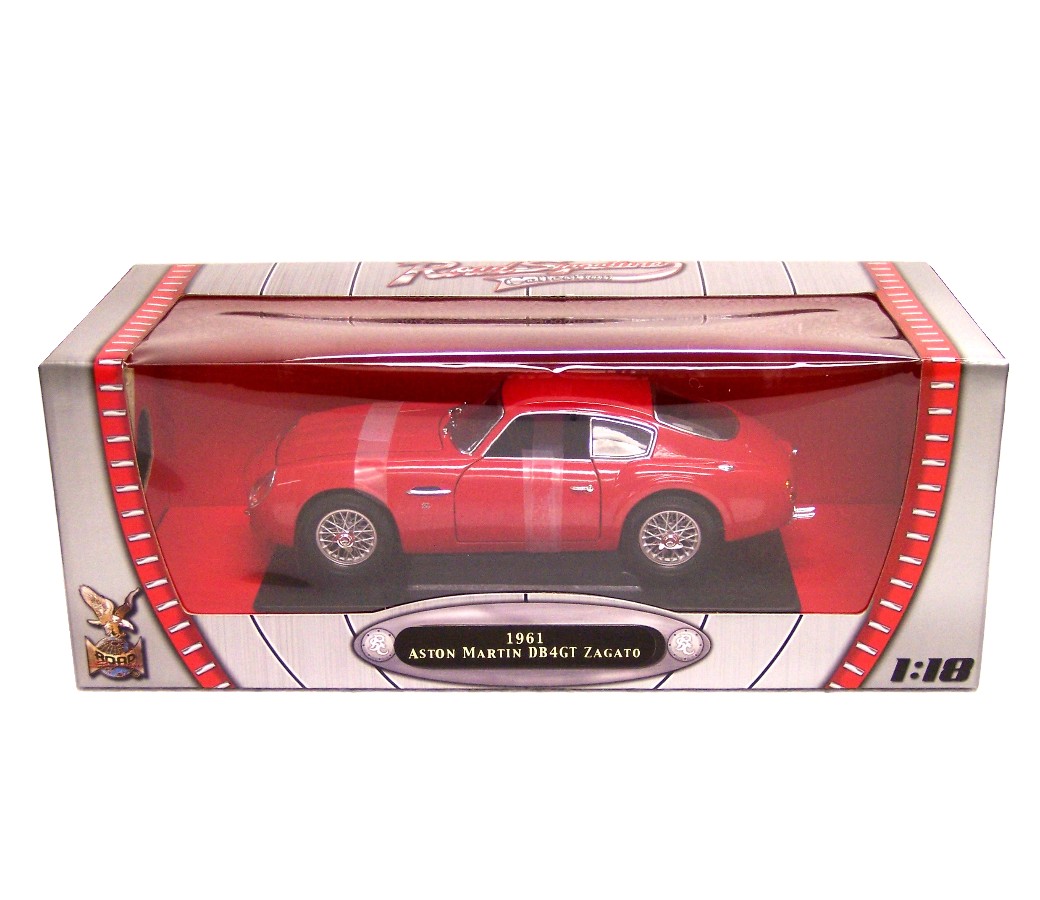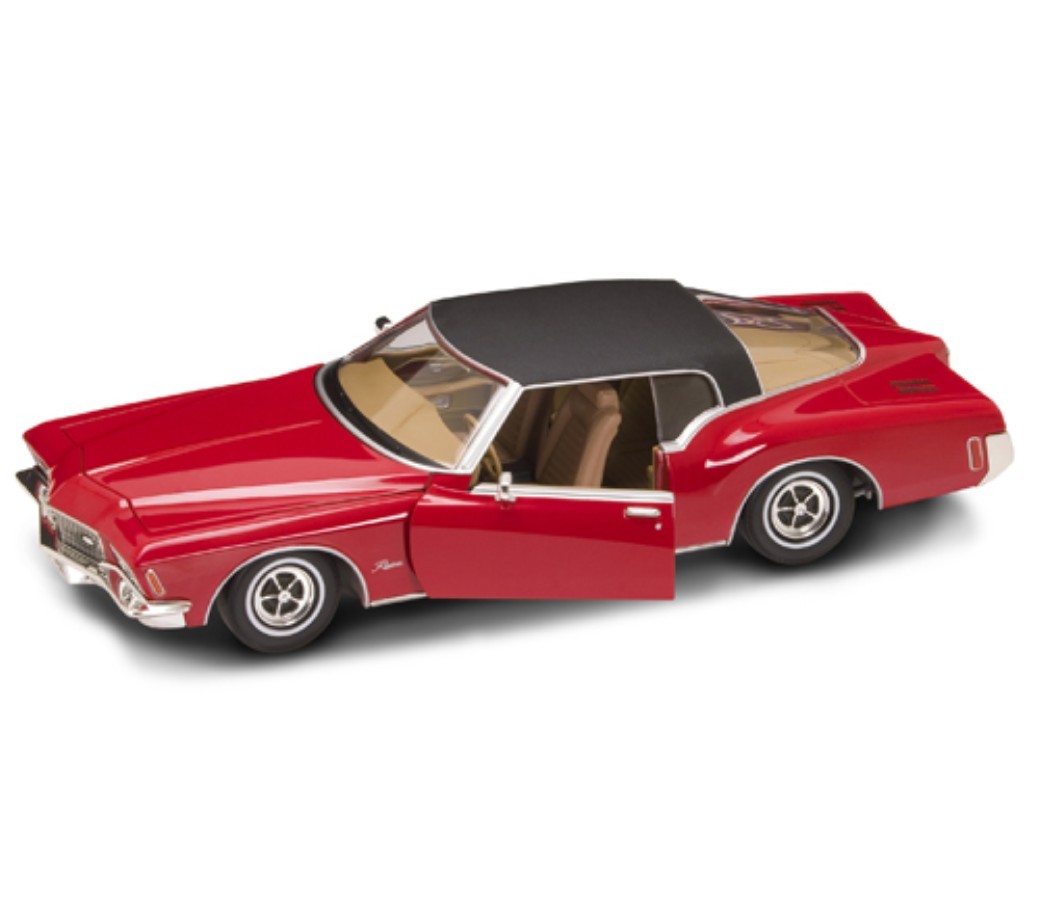
1:18 1971 BUICK RIVIERA GS WITH VINYL TOP i is a high quality and low price product, and the price is most competitive compare with other providers. Moreover, we will give you more discount if you purchase in big quantity. When the order has done, we will choose the best way ship to you, according to the shipping address you have give to us. Our goal is to satisfy the customers with providing superior quality, up-to-date design, competitive price, fast delivery and excellent service. We want to make sure our customers confident in our products in all aspects. Enjoy your online shopping and welcome to our website again, thank you!
Purchase: [WHOLESALE] [RETAIL] [RETAIL]
-
1:18 scale diecast model of 1971 BUICK(T) RIVIERA GS WITH VINYL TOP die cast car by Road Signature
-
Item comes packaged new in a window box.
-
Made of diecast with some plastic parts.
-
Detailed interior, exterior.
-
-
Authentically reproduced body styling and accurate details and rolling wheels.
-
Chromed ‘big ‘n little” spoke rims w/ matching treaded rubber tires.
-
Dimensions approximately L-10, W-4, H-2.5 inches
Buick Riviera
The Riviera by Buick is an automobile produced by Buick in the United States from the 1963 to 1999 model years, with 1,127,261 produced.
A full-size hardtop, a specially trimmed and stretched sedan, or a personal luxury car, the early models of the Riviera in particular have been highly praised by automotive journalists and writers.
A common misconception is that all Rivieras produced after the 1965 model are front wheel drive cars; this is true only of the 1979-1999 models. In contrast, the Riviera’s E-body stablemates, the Oldsmobile Toronado and Cadillac Eldorado (subsequent to its change in platform in 1967), were always front-wheel drive.
Origin of the name
The Riviera name first entered the Buick line in 1949 as the designation for the new two-door pillarless hardtop, which was described in advertising as “stunningly smart.” The Buick Roadmaster Riviera coupe (along with the Cadillac Coupe de Ville and Oldsmobile 98 Holiday coupe) constituted the first mass production use of this body style, which was to become extremely popular over the next 30 years. Buick would add a 2-door Riviera hardtop to the Super the following year, the Special in 1951 and the Century upon its return, after a 12 year absence, in 1954.
From 1951 to 1953 the “Riviera” designation was also used on long wheelbase versions of the 4-door Buick Roadmaster and Super sedans (a long wheelbase sedan was offered on both lines in 1950 but they were not called Rivieras). The 1951-53 Buick Roadmaster and Super 4-door Riviera sedans featured more standard features, more plush interior trim and, most significantly, a wheelbase (and overall length) that was 4 inches (102 mm) longer than a regular Buick Roadmaster or Super 4-door sedan. The 1951-52 Buick Super 4-door Riviera sedan was still 0.75 inches (19 mm) shorter in wheelbase and length than the regular Buick Roadmaster and 4.75 inches (121 mm) shorter than the Roadmaster 4-door Riviera sedan. In 1953, with the move from the Fireball straight-eight to the more compact Nailhead V8 engine, the Roadmaster and Super 4-door Riviera sedans became the same length.
In the middle of the 1955 model year Buick and Oldsmobile introduced the world’s first mass-produced four-door hardtops, with Buick offering it only on the Century and Special models, and the “Riviera” designation was also applied to these body styles. Four-door Riviera hardtops were added to the Roadmaster and Super lines at the beginning of the following model year. However, since it was a body style designation and not a model, the Riviera name did not usually appear on the car.
In 1959, Buick became much more selective in applying the Riviera name. From then until 1963 it only was used to denote a premium trimmed 6-window hardtop style which it initially shared exclusively with Cadillac (the Oldsmobile 98 would receive it in 1961) and was available only on the Electra 225. The last usage of the term “Riviera” to describe hardtops was 1963, as the formal designation of the #4829 Electra 225 Riviera four-door hardtop. Coincidentally, this was the same year the Riviera would become a separate model in its own right.
Origins of the personal luxury car
In the late 1950s, GM began to feel the need for a personal luxury car to compete with the highly successful Ford Thunderbird — a uniquely styled, two-door, four-passenger car with an image of both comfort and performance. The design that became the first Riviera was created as a Cadillac model, the XP-715, possibly to be called LaSalle, after Cadillac’s smaller “companion” car of the 1930s. Its styling was reportedly inspired by GM styling chief Bill Mitchell’s visit to London during the period, when he was struck by the sight of an elegant, custom-bodied Rolls Royce in the fog. He later said that “knife-edged” styling was what he wanted for the new model, but with a lower profile and a bit of Ferrari thrown in for performance. The design itself was penned by stylist Ned Nickles.
The management of Cadillac was not particularly interested, since the division was very successful at the time and needed all their production capacity for their existing models. In an unusual move, in 1960 the project was thrown open for competition by the other divisions. Buick, which was desperate to revive its flagging sales, enlisted the aid of the McCann-Erickson advertising agency, with which it had just signed, to create its presentation. Buick won, and the finished design was adapted to a shortened version of Buick’s cruciform frame. The design was substantially the same as the original, although the hidden headlights — originally concealed in the fender grilles — were initially omitted for cost reasons.
First generation (1963–1965)
The production Riviera shared its bodyshell with no other model, which was unusual for a GM product. It rode a cruciform frame similar to the standard Buick frame, but shorter and narrower, with a 2.0 in (51 mm) narrower track. Its wheelbase of 117 in (3,000 mm) and overall length of 208 in (5,300 mm) were 6.0 inches (150 mm) and 7.7 in (200 mm) shorter, respectively, than a Buick LeSabre, but slightly longer than a contemporary Thunderbird. At 3,998 lb (1,813 kg), it was about 390 pounds (180 kg) lighter than either. It shared the standard Buick V8 engines, with a displacement of either 401 cu in (6.57 L) or 425 cu in (6.96 l), and the unique continuously-variable design Twin Turbine automatic transmission. Power brakes were standard, using Buick’s massive “Al-Fin” (aluminum finned) drums of 12 in (300 mm) diameter. Power steering was standard equipment, with an overall steering ratio of 20.5:1, giving 3.5 turns lock-to-lock.
The Riviera’s suspension used the same basic design as standard Buicks, with double wishbones front and a live axle located by trailing arms and a lateral track bar, but the roll centers were raised to reduce body lean. Although its coil springs were actually slightly softer than other Buicks, with the lighter overall weight, the net effect was to make the Riviera somewhat firmer. Although still biased towards understeer, contemporary testers considered it one of the most roadable American cars, with an excellent balance of comfort and agility.
The Riviera was introduced on October 4, 1962 as a 1963 model, with the 325 hp (242 kW) 401 cu in (6.6 l) “Nailhead” V-8 as the only available engine,[4] fitted with dual exhaust as standard equipment, and the Turbine Drive the only transmission,[5] at a base price of $4,333;[6] typical delivered prices with options ran upwards of $5,000. Buick announced in December, 1962, the availability of a 340 hp (250 kW) 425 cu in (7.0 l) version of the Nailhead as an option. Total production was deliberately limited to 40,000 vehicles (in a year that Buick sold 440,000 units overall) to emphasize its exclusivity and to increase demand; only 2,601 of them were delivered with the 425 cu in (7.0 l) engine in the 1963 model year.
With the same power as the larger Buicks and less weight, the Riviera had sparkling all-around performance: Motor Trend found it capable of running 0–60 mph (0–97 km/h) in 8 seconds or less, the standing quarter mile in about 16 seconds, and an observed top speed of 115 miles per hour (185 km/h), although 125 miles per hour (201 km/h) was feasible with a longer run. Fuel economy was a meager 13.2 miles per US gallon (17.8 L/100 km; 15.9 mpg-imp). Front leg room was 40.1 inches.
Inside, the Riviera featured a four-place cabin with front bucket seats separated by a center console with floor shifter and storage compartment that was built into the instrument panel, and bucket-style seats in the rear. Upholstery choices included all-vinyl, cloth and vinyl, or optional leather. A deluxe interior option included real walnut inserts on the doors and below the rear side windows. Popular extra-cost options included a tilt steering wheel, power windows, power driver’s seat, air conditioning, a remote-control side view mirror, and white sidewall tires.
The Riviera continued with minimal trim changes for 1964 including the discontinuation of leather upholstery from the option list, differing mainly in substitution of the old Dynaflow-based Twin Turbine for the new three-speed Super Turbine 400, which was marketed as Turbo Hydra-Matic by other GM divisions. This was the first year that the Stylized “R” emblem was used on the Riviera, a trademark that would continue throughout the remainder of Riviera’s 36-year production run. Under the hood, the 401 cu in (6.6 l) was dropped as the standard power plant in favor of the previously optional 340 hp (254 kW) 425 cu in (7.0 l) V8. A ‘Super Wildcat’ version was optionally available, with dual Carter AFB four-barrel carburetors, rated at 360 hp (268 kW).
Changes for 1965 included the introduction of the Gran Sport option, which included the dual-quad Super Wildcat 425 V8, a numerically higher 3.42 axle ratio, and stiffer, heavy-duty suspension. The stock dual exhaust pipes were increased from 2.0 inches (51 mm) to 2.25 inches (57 mm) inside diameter and had less turns to reduce backpressure. The 401 cu in (6.6 l) V8 returned as the standard Riviera engine and the Super Turbine 400 transmission now had a variable pitch torque converter like the old Twin Turbine Dynaflow had two years before. Externally, the headlamps were concealed behind clamshell doors in the leading edges of each fender, as in the original design. Further back, the non-functional side scoops between the doors and rear wheel arches were removed, and the taillights were moved from the body into the rear bumper.[8] A vinyl roof became available as an option, initially offered only in black, and the tilt steering wheel optional in previous years was now standard equipment.
Total sales for the three model years was a respectable 112,244. All in all, the Riviera was extremely well received and considered a great success, giving the Thunderbird its first real competition.
The first-generation Riviera is considered a styling landmark, and is quite collectible today.
The 1963-1965 Riviera met with approval from all quarters, and has since earned Milestone status from the Milestone Car Society. Jaguar founder and designer Sir William Lyons said that Mitchell had done “a very wonderful job,” and Sergio Pininfarina declared it “one of the most beautiful American cars ever built; it has marked a very impressive return to simplicity of American car design.” At its debut at the Paris Auto Show, Raymond Loewy said the Riviera was the handsomest American production car—apart from his own Studebaker Avanti, that is, the Riviera’s only real competition for 1963.
Second generation (1966–1970)
The Riviera was redesigned for the 1966 model year. It retained its cruciform frame, powertrain, and brakes, but it wore a longer, wider, more curvaceous body, a shell it now shared with the Oldsmobile Toronado, and, a year later, with the Cadillac Eldorado. A notable styling point was the absence of vent windows, a feature GM had introduced with a flourish in the 1930s. Headlamps remained concealed, but they now pivoted up above the grille when not in use. Unlike the Toronado and Eldorado, the Riviera retained a conventional rear wheel drive layout. It was now some 200 pounds (91 kg) heavier, so acceleration with the unchanged 425 engine was slightly slower. The Gran Sport package remained available as an option. Rear seat belts were optional. AM/FM radio is optional.
Inside, the four-place cabin with front and rear bucket seats and center console was replaced by a choice of bucket seats or conventional bench seats as standard equipment, making the Riviera a full six-passenger car for the first time. Optionally available was a Strato-bench seat with armrest or Strato bucket seats with either a short consolette or a full-length operating console with a “horseshoe” shaped floor shifter and storage compartment. Both the buckets and Strato-bench seat were available with a reclining seat option for the passenger’s side. Sales for 1966 rebounded to 45,308, a new record.
The most significant change for 1967 was the adoption of Buick’s entirely new V8 of 430 cu in (7.0 L) displacement, 360 horsepower (270 kW) and 475 lb·ft (644 N·m) of torque to replace the old 425 “nailhead”. The new engine, with greater power and torque on hand, represented a significant performance improvement. Gasoline mileage improved slightly with the new engine, though it remained gas-thirsty compared to modern cars. Powerful Disc brakes with Bendix 4 piston calipers became optional for the front wheels but most Riviera continued to be ordered with Buick’s aluminum brake drums which were almost as good. Cosmetically, changes were few, and were limited to the addition of a wide, full-width, center-mounted horizontal chrome grille bar that stretched over the headlight doors and outboard parking lights. Sales eased to 42,799 for the 1967 model year. The Riviera had full instrumentation.
1968 models had reshaped front and rear loop-type bumpers that encased the vehicle’s (recessed crosshatch) grille and tail lamps, respectively. Hidden wiper arms were also new. Federally-mandated side marker lights were of an inverted trapezoidal shape on the lower leading edges of the front fenders. Rear marker lights were circular. The interior was restyled and, unlike the 1966-67 models, shared its instrument panel with the other full-size Buick models. There were very few mechanical changes in 1968 but the transmission lost its variable pitch torque converter. Sales set another new record in 1968, as 49,284 units were sold.
For 1969, minor styling changes took place. Grilles changed from the crosshatch pattern seen in ’68 to a pattern of finely-spaced, slim vertical bars overlaid by two wider horizontal bars, which jutted forward at their inboard edges. Front marker lights became far shorter, and square in shape. Chrome side trim was revised, as well. At the rear, the reverse lights were move from the rear bumper into the ’69 Riviera’s new 3-section tail light lenses. Sales for 1969 improved again, to 52,872. A new front suspension system was used.
The 1970 Riviera was restyled. Exposed quad headlamps were nearly flush-mounted, while the new front bumper wrapped around and over the new vertical bar grille, set between the headlamp pods. A newly optional side trim feature accented the large coupe’s flowing lines. Skirted rear wheels became standard, with exposed wheels an option. At the rear, a new rear bumper/taillight motif was seen. The engine was upgraded to 455 cu in (7.46 L), the largest engine Buick offered to date, rated at 370 horsepower (280 kW) gross, 245 hp (183 kW) net, and over 500 lb·ft (680 N·m) of torque. Despite the fact that ’70 sales dropped to 37,366, the second-generation Riviera proved more successful than the first, with 227,669 units sold over five seasons
Third generation (1971–1973)
The Riviera was radically redesigned for the 1971 model year with flowing and dramatic “boat-tail” styling. Designed under Bill Mitchell’s direction, it was penned by Jerry Hirshberg, future head of design for Nissan, mating the two-piece vee-butted[18] fastback rear window, inspired by the 1963 Corvette Sting Ray split window coupe, to the Riviera’s platform. The design was originally intended for the smaller GM A platform, and the use of the Riviera’s body—expanded for 1971 by 3 in (76 mm) in wheelbase and more than 120 lb (54 kg) heavier—produced controversial looks. (Collectible Automobile ran an article about 1971-76 full-sized Buicks where one sketch design for their 2-door coupes which was rejected resembled the 1971-73 Riviera.) The 455 engine had a lower compression ratio to meet EPA emissions requirements, reducing power to 255 hp (190 kW), with 265 hp (198 kW) in the Gran Sport. Performance remained reasonably brisk, with a 0-60 time of 8.1 seconds for the GS, but the Riviera’s sporty image was rapidly fading. One noteworthy advance was Buick’s Max Trac, a traction control system that prevented wheelspin during acceleration on slippery surfaces.[19] The 1971 Riviera also features GM’s “Full-Flo” ventilation system and two large deck lid louvers are prominent on the trunk lid. (Unfortunately, under certain conditions a vacuum was created that sucked rain and exhaust back into the car and the “Full-Flo” ventilation was redesigned and the louvers were removed from trunk lid for the 1972 model year.)
Third generation “boat-tail”
Despite these features, Riviera sales for 1971 dropped to 33,810,[20] the lowest to date. The 1972 Riviera was little changed, with the 455 engine switching to net power ratings, 225 hp (168 kW) or 250 hp (190 kW) with the Gran Sport, although the actual drop in net power was only 5 hp (3.7 kW). Sales remained moribund at 33,728.[21] For 1973, the 250 hp (186 kW) engine became standard, with 260 hp (190 kW) with the Stage One package, which also included a limited slip differential and a chrome-plated air cleaner. The “Gran Sport” package was still available as a separate option package consisting of a ride-and-handling package that included a rear stabilizer bar, JR78-15 whitewall steel-belted radial tires, a specially tuned “radial roadability” suspension, additional sound insulation and special “Gran Sport” badging. The 1973 model is also distinguished from the 1972 models in that the rear “boat-tail” is somewhat less pronounced than on the 1972 model, resulting in a flatter rear bumper.
Fourth generation (1974–1976)
Although carrying over the same platform, mechanicals, and some body panels seen on the “Third Generation” Riviera, Buick replaced its distinctive ‘boat tail’ roofline with a more conventional-looking “Colonnade” treatment. This turned the car from a hardtop coupe into a pillared coupe, as it featured wide B pillars and fixed quarter opera windows. A landau half-vinyl roof option was available. The car did retain its forward-jutting grille, albeit in slightly modified form. Thus modified, the car looked far less distinctive than its predecessors, and even its platform mates, the Oldsmobile Toronado and Cadillac Eldorado. The tamer-looking Riviera was no lighter, and its standard 455 V8 lost more power, dropping to 230 hp (172 kW) and 245 hp (183 kW) for standard and Stage One models, respectively. Max Trac was dropped from the option list after 1974 due lack of buyer interest. The revised styling did nothing for sales, which plummeted to 20,129 in 1974.
For 1975, the Riviera received an updated front fascia, which lost its forward-jutting theme through the redesign of the fiberglass front end cap. Quad rectangular headlights were mounted horizontally. The new vertical-bar grille echoed the “stand-up” theme that many GM cars of the day incorporated. Parking lights wrapped around the fender sides. The Stage One performance package was dropped for 1975, though the Gran Sport handling package would continue to be offered. The standard engine’s output dipped to 205 hp (153 kW). Sales for 1975 were 17,306.
Minor changes greeted 1976 models, the most notable of which was a new crosshatch grille insert. The Gran Sport handling package was replaced by an ‘S/R’ package that had similar sporting pretensions. Sales rallied slightly to 20,082 for 1976.
Fifth generation (1977–1978)
Buick downsized the Riviera for 1977 (unlike Cadillac and Oldsmobile, which downsized a couple of years later), sharing the new smaller GM B platform. While the other E-bodies were front wheel drive since 1966 (1967 for Cadillac’s Eldorado), the Buick E platform used a B-body undercarriage (along with the cruciform frame of pre-1965 GMs for the 1966-70 generation). All B-bodies (including C and D platform GM RWDs) were downsized for the 1977 model year which prompted the short-lived 1977/78 generation.
It was, in most respects, a Buick LeSabre coupe with unique styling (with quarter windows mimicking the 1975-78 Cadillac Eldorado). Unlike its LeSabre counterpart, the front fascia is vertical as opposed to slanted. It was reduced to a wheelbase of 115.9 in (2,940 mm), down 6.1 in (150 mm), and an overall length of 218.2 in (5,540 mm), down 4.8 in (120 mm). Weight dropped some 660 pounds (300 kg). The 455 was gone, replaced by a 350 cu in (5.7 L) Buick V8 engine with 155 hp (116 kW) or Oldsmobile-built 403 cu in (6.60 L) with 185 hp (138 kW). California models had a 170 hp (127 kW) Oldsmobile 350.
Sales were up modestly to 26,138 for 1977 and then fell to 20,535 for 1978, although this was strictly a stopgap model until the all-new E-body cars would be ready for 1979. To date, 1977 and 1978 Rivieras are considered a rare find since it was only produced for two model years on the downsized GM B platform before the 1979 redesign on the FWD E-platform (there are two reasons why the B-platform was used – the existing 1976 B-platform was phased out for the downsized variant where RWD E-platform vehicles were produced on the B-chassis. Buick could have continued production although the frame stamping facilities and undercarriage/chassis components were being retooled in late 1976 for downsized B-platform production where the FWD E-platform did not downsize since they were produced on a separate assembly line.
Also, with Buick dropping its 455 V8 after 1976, continuing the ’77-78 Riviera on the old E-body platform would have forced Buick to either downsize its engine compartment to their 350 V8, which was too small and underpowered for a 5,000-pound car – or “import” larger engines from other GM divisions including 400s from Chevrolet and Pontiac, Oldsmobile’s 403 or Cadillac’s 425 – each of which would have limited sales and production as each division gave first priority to its own vehicles before selling engines to other divisions.
Buick Riviera: 75th Anniversary Package
For 1978, a special “LXXV” edition was released to commemorate Buick’s 75th anniversary on the market. Production total was 2,889 and included special silver & black paint with gray leather seats with black trim, brushed chrome trim, deep pile carpeting and special LXXV name plates
Sixth generation (1979–1985)
1979 saw the debut of the first front wheel drive Riviera on a trimmer, 114 in (2,900 mm) wheelbase, once again sharing its mechanical design and platform with the Cadillac Eldorado and Oldsmobile Toronado. The Olds 403 and Buick 350 were dropped, but the Olds 350 remained, as did a new turbocharged Buick V6 of 231 cu in (3.8 L) displacement with 185 hp (138 kW). The Riviera became Motor Trend’s Car of the Year. Sales more than doubled, to 52,181 for 1979 and 48,621 for the very similar 1980 models.
1981 saw the Turbo renamed T-Type and the demise of the 350 engine in favor of the Oldsmobile-built 307 cu in (5.03 L) with 140 hp (104 kW) (phased in during the 1980 MY). The standard engine was now Buick’s 125 hp (93 kW) 252 cu in (4.13 L) V6, and a new option was an Oldsmobile diesel engine with a mere 105 hp (78 kW). offered through 1985. 1982 also saw the first-ever Riviera convertible, although relatively few were built, owing to very high prices-US$23,944. Riviera convertible was available in only two color choices-white or red firemist with the only interior color of red leather. A turbocharged Riviera convertible was chosen to be the pace car at the 1983 Indianapolis 500, although most convertible Rivieras had the V8 engine, which saw an increase in rated SAE net horse power to 150 for both convertibles and coupes fitted with it from 1982 through the 1985 model year.
Overall sales made the 1980s Riviera a great success, reaching 65,305 for the 1985 model year.
Seventh generation (1986–1993)
The E-body coupes were converted to unibody construction and further downsized for 1986, to a 108 in (2,700 mm) wheelbase shared with the Buick Regal. The V6 was now the only engine, rated initially at 142 hp (106 kW) SAE and 200 lb·ft (270 N·m) of torque. It used the Turbo-Hydramatic 440-T4 automatic with a 2.84:1 final drive ratio. This generation was noted for advanced electronic instrumentation, including the first automotive touchscreen controls, which were on a dash-mounted 9-inch (230 mm) CRT display. Four-wheel disc brakes were standard. With a choice of three suspension packages available, up to the performance oriented FE3 setting, handling was notably improved. The Riviera placed fourth for Motor Trend’s 1986 Car of the Year contest.
Fuel economy was notably improved for the 1986 Riviera, but the substantial investment in the downsized, transverse engine front wheel drive platform resulted in a substantial price increase, to $19,831 to the base model and $21,577 for the new T-Type. Downsizing also resulted in a dimensional similarity to smaller, less expensive offerings from GM, with shared styling cues reinforcing the unfortunate resemblance.
1989-1993 Buick Riviera
The smaller dimensions, generic styling, and lack of V8 power soured buyers, and sales plummeted to 22,138 for 1986, only 15,223 for 1987, and a dismal 8,625 for 1988. A restyle for 1989 that added 11 inches (280 mm) to the overall length (on an unchanged wheelbase) helped, but only incrementally, boosting sales to 21,189 for 1989, but dropping to a low of 4,555 for 1993, the shortened final year of that model. The last 1993 Riviera rolled off the Detroit/Hamtramck Assembly plant line on December 10, 1992.
Sales in the personal luxury coupe segment were in decline from 1986 onward, although it is unclear whether the general market trend was initiated by the poor public reception of GM’s newly downsized offerings or an inevitable shift in the tastes of the buying public.
Eighth generation (1995–1999)
There was no 1994 Riviera, but a restyled, larger model returned for 1995, now with the option of a supercharged version of the 3800 V6 rated at 225 hp (168 kW) and 275 ft·lbf (373 N·m). Also available was the standard 205 hp (153 kW) naturally aspirated 3800 V6. The new Rivieras were built in Lake Orion, Michigan, riding the same Cadillac-derived G platform as the 4-door Oldsmobile Aurora. The very first of 41,422 Rivieras made for 1995 rolled off the assembly line on May 23, 1994.
1996 brought an increase in power on the supercharged versions to 240 hp (179 kW) and 280 ft·lbf (380 N·m). 18,036 Rivieras were manufactured for 1996.
1997 saw revisions to the suspension which lightened the car and gave it more nimble handling, and also an upgraded 4T65E-HD transmission featuring a larger 258 mm (10.2 in) torque converter and heavy-duty gearbox. 18,827 were made for 1997.
For 1998, the 240 hp (180 kW) supercharged V6 became standard. GM’s OnStar service was added as an option, and a few interior changes were made. 10,953 units were produced for 1998.
1999 was the last model year for the Riviera, a very short one, with production of 1,956 cars ceasing on November 25, 1998. The final 200 cars had special silver paint and trim, and were denoted “Silver Arrow” models, a designation which hearkened back to several Silver Arrow show cars that had been built off Riviera bodies by Bill Mitchell.
The 1995-1999 Rivieras received the most powerful Buick engine since the legendary Grand Nationals of the 1980s. The supercharged OHV V6 gave impressive torque and acceleration, pushing the car from 0 to 60 miles per hour (97 km/h) in under 8 seconds, and turning the 1/4 mile in 15.5 seconds. These numbers, combined with the Riviera’s large size and unassuming looks, qualified it as a sleeper, a car with not-so-obvious yet potent performance potential. Additionally, supercharged Rivieras achieved a respectable fuel efficiency figure of 18/27 (city/highway mpg).
